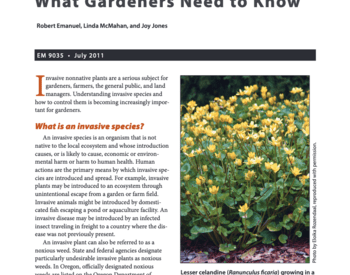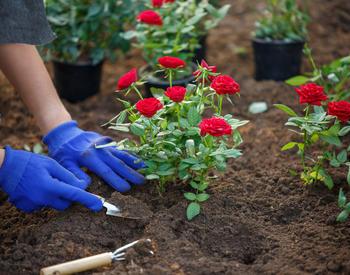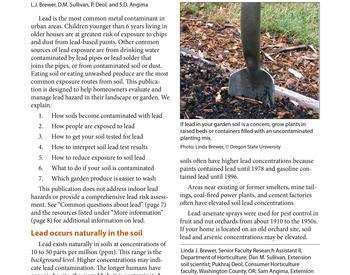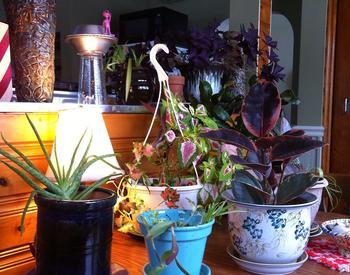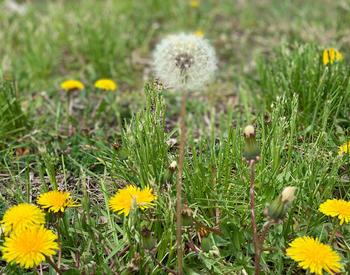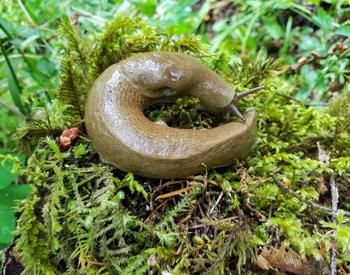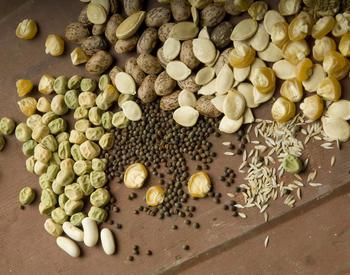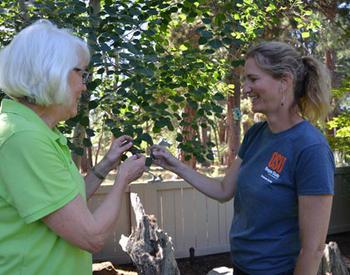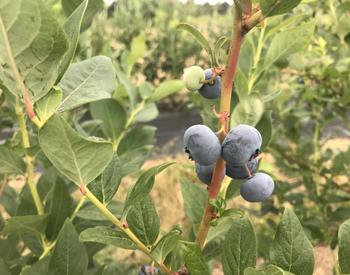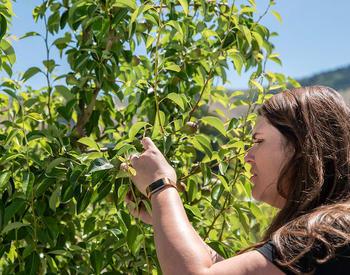Plant growth and geographic distribution (where the plant can grow) are greatly affected by the environment. If any environmental factor is less than ideal, it limits a plant's growth and/or distribution. For example, only plants adapted to limited amounts of water can live in deserts.
Either directly or indirectly, most plant problems are caused by environmental stress. In some cases, poor environmental conditions (e.g., too little water) damage a plant directly. In other cases, environmental stress weakens a plant and makes it more susceptible to disease or insect attack.
Environmental factors that affect plant growth include light, temperature, water, humidity and nutrition. It's important to understand how these factors affect plant growth and development. With a basic understanding of these factors, you may be able to manipulate plants to meet your needs, whether for increased leaf, flower or fruit production. By recognizing the roles of these factors, you'll also be better able to diagnose plant problems caused by environmental stress.
Light
Three principal characteristics of light affect plant growth: quantity, quality and duration.
Quantity
Light quantity refers to the intensity, or concentration, of sunlight. It varies with the seasons. The maximum amount of light is present in summer, and the minimum in winter. Up to a point, the more sunlight a plant receives, the greater its capacity for producing food via photosynthesis.
You can manipulate light quantity to achieve different plant growth patterns. Increase light by surrounding plants with reflective materials, a white background or supplemental lights. Decrease it by shading plants with cheesecloth or woven shade cloths.
Quality
Light quality refers to the color (wavelength) of light. Sunlight supplies the complete range of wavelengths and can be broken up by a prism into bands of red, orange, yellow, green, blue, indigo and violet.
Blue and red light, which plants absorb, have the greatest effect on plant growth. Blue light is responsible primarily for vegetative (leaf) growth. Red light, when combined with blue light, encourages flowering. Plants look green to us because they reflect, rather than absorb, green light.
Knowing which light source to use is important for manipulating plant growth. For example, fluorescent (cool white) light is high in the blue wavelength. It encourages leafy growth and is excellent for starting seedlings. Incandescent light is high in the red or orange range, but generally produces too much heat to be a valuable light source for plants. Fluorescent grow-lights attempt to imitate sunlight with a mixture of red and blue wavelengths, but they are costly and generally no better than regular fluorescent lights.
Duration
Duration, or photoperiod, refers to the amount of time a plant is exposed to light. Photoperiod controls flowering in many plants (Figure 1). Scientists used to think that the length of light period triggered flowering and other responses within plants. Thus, they describe plants as short-day or long-day, depending on what conditions they flower under. We now know that it is not the length of the light period, but rather the length of uninterrupted darkness, that is critical to floral development.
Plants are classified into three categories: short-day (long-night), long-day (short-night), or day-neutral, depending on their response to the duration of light or darkness. Short-day plants form flowers only when day length is less than about 12 hours. Many spring- and fall-flowering plants, such as chrysanthemum, poinsettia and Christmas cactus, are in this category.
In contrast, long-day plants form flowers only when day length exceeds 12 hours. Most summer-flowering plants (e.g., rudbeckia, California poppy and aster), as well as many vegetables (beet, radish, lettuce, spinach and potato), are in this category.
Day-neutral plants form flowers regardless of day length. Examples are tomato, corn, cucumber and some strawberry cultivars. Some plants do not fit into any category, but may respond to combinations of day lengths. Petunias, for example, flower regardless of day length, but flower earlier and more profusely with long days.
You can easily manipulate photoperiod to stimulate flowering. For example, chrysanthemums normally flower in the short days of spring or fall, but you can get them to bloom in midsummer by covering them with a cloth that completely blocks out light for 12 hours each day. After several weeks of this treatment, the artificial dark period no longer is needed, and the plants will bloom as if it were spring or fall. This method also is used to make poinsettias flower in time for Christmas.
To bring a long-day plant into flower when day length is less than 12 hours, expose the plant to supplemental light. After a few weeks, flower buds will form.
Temperature
Temperature influences most plant processes, including photosynthesis, transpiration, respiration, germination and flowering. As temperature increases (up to a point), photosynthesis, transpiration and respiration increase. When combined with day length, temperature also affects the change from vegetative (leafy) to reproductive (flowering) growth. Depending on the situation and the specific plant, the effect of temperature can either speed up or slow down this transition.
Germination
The temperature required for germination varies by species. Generally, cool-season crops (e.g., spinach, radish and lettuce) germinate best at 55° to 65°F, while warm-season crops (e.g., tomato, petunia and lobelia) germinate best at 65° to 75°F.
Flowering
Sometimes horticulturists use temperature in combination with day length to manipulate flowering. For example, a Christmas cactus forms flowers as a result of short days and low temperatures (Figure 1). To encourage a Christmas cactus to bloom, place it in a room with more than 12 hours of darkness each day and a temperature of 50° to 55°F until flower buds form.
If temperatures are high and days are long, cool-season crops such as spinach will flower (bolt). However, if temperatures are too cool, fruit will not set on warm-season crops such as tomato.
Crop quality
Low temperatures reduce energy use and increase sugar storage. Thus, leaving crops such as ripe winter squash on the vine during cool, fall nights increases their sweetness.
Adverse temperatures, however, cause stunted growth and poor-quality vegetables. For example, high temperatures cause bitter lettuce.
Photosynthesis and respiration
Thermoperiod refers to daily temperature change. Plants grow best when daytime temperature is about 10 to 15 degrees higher than nighttime temperature. Under these conditions, plants photosynthesize (build up) and respire (break down) during optimum daytime temperatures and then curtail respiration at night. However, not all plants grow best under the same range between nighttime and daytime temperatures. For example, snapdragons grow best at nighttime temperatures of 55°F; poinsettias, at 62°F.
Temperatures higher than needed increase respiration, sometimes above the rate of photosynthesis. Thus, photosynthates are used faster than they are produced. For growth to occur, photosynthesis must be greater than respiration.
Daytime temperatures that are too low often produce poor growth by slowing down photosynthesis. The result is reduced yield (i.e., fruit or grain production).
Breaking dormancy
Some plants that grow in cold regions need a certain number of days of low temperature (dormancy). Knowing the period of low temperature required by a plant, if any, is essential in getting it to grow to its potential.
Peaches are a prime example; most varieties require 700 to 1,000 hours between 32° and 45°F before breaking their rest period and beginning growth. Lilies need six weeks of temperatures at or slightly below 33°F before blooming.
Daffodils can be forced to flower by storing the bulbs at 35° to 40°F in October. The cold temperature allows the bulbs to mature. When transferred to a greenhouse in midwinter, they begin to grow, and flowers are ready to cut in three to four weeks.
Hardiness
Plants are classified as hardy or nonhardy depending on their ability to withstand cold temperatures. Hardy plants are those that are adapted to the cold temperatures of their growing environment.
Woody plants in the temperate zone have very sophisticated means for sensing the progression from fall to winter. Decreasing day length and temperature trigger hormonal changes that cause leaves to stop photosynthesizing and to ship nutrients to twigs, buds, stems and roots. An abscission layer forms where each petiole joins a stem, and the leaves eventually fall off. Changes within the trunk and stem tissues over a relatively short period of time "freeze-proof" the plant.
Winter injury to hardy plants generally occurs when temperatures drop too quickly in the fall before a plant has progressed to full dormancy. In other cases, a plant may break dormancy in mid- or late winter if the weather is unseasonably warm. If a sudden, severe cold snap follows the warm spell, otherwise hardy plants can be seriously damaged.
It is worth noting that the tops of hardy plants are much more cold-tolerant than the roots. Plants that normally are hardy to 10°F may be killed if they are in containers and the roots are exposed to 20°F.
Winter injury also may occur because of desiccation (drying out) of plant tissues. People often forget that plants need water even during winter. When the soil is frozen, water movement into a plant is severely restricted. On a windy winter day, broadleaf evergreens can become water-deficient in a few minutes, and the leaves or needles then turn brown. To minimize the risk of this type of injury, make sure your plants go into the winter well watered.
Water and humidity
Most growing plants contain about 90 percent water. Water plays many roles in plants. It is:
- A primary component in photosynthesis and respiration
- Responsible for turgor pressure in cells (Like air in an inflated balloon, water is responsible for the fullness and firmness of plant tissue. Turgor is needed to maintain cell shape and ensure cell growth.)
- A solvent for minerals and carbohydrates moving through the plant
- Responsible for cooling leaves as it evaporates from leaf tissue during transpiration
- A regulator of stomatal opening and closing, thus controlling transpiration and, to some degree, photosynthesis
- The source of pressure to move roots through the soil
- The medium in which most biochemical reactions take place
Relative humidity is the ratio of water vapor in the air to the amount of water the air could hold at the current temperature and pressure. Warm air can hold more water vapor than cold air. Relative humidity (RH) is expressed by the following equation:
RH = water in air ÷ water air could hold (at constant temperature and pressure)
Relative humidity is given as a percent. For example, if a pound of air at 75°F could hold 4 grams of water vapor, and there are only 3 grams of water in the air, then the relative humidity (RH) is:
3 ÷ 4 = 0.75 = 75%
Water vapor moves from an area of high relative humidity to one of low relative humidity. The greater the difference in humidity, the faster water moves. This factor is important because the rate of water movement directly affects a plant's transpiration rate.
The relative humidity in the air spaces between leaf cells approaches 100 percent. When a stoma opens, water vapor inside the leaf rushes out into the surrounding air (Figure 2), and a bubble of high humidity forms around the stoma. By saturating this small area of air, the bubble reduces the difference in relative humidity between the air spaces within the leaf and the air adjacent to the leaf. As a result, transpiration slows down.
If wind blows the humidity bubble away, however, transpiration increases. Thus, transpiration usually is at its peak on hot, dry, windy days. On the other hand, transpiration generally is quite slow when temperatures are cool, humidity is high, and there is no wind.
Hot, dry conditions generally occur during the summer, which partially explains why plants wilt quickly in the summer. If a constant supply of water is not available to be absorbed by the roots and moved to the leaves, turgor pressure is lost and leaves go limp.
Plant nutrition
Plant nutrition often is confused with fertilization. Plant nutrition refers to a plant's need for and use of basic chemical elements. Fertilization is the term used when these materials are added to the environment around a plant. A lot must happen before a chemical element in a fertilizer can be used by a plant.
Plants need 17 elements for normal growth. Three of them--carbon, hydrogen and oxygen--are found in air and water. The rest are found in the soil.
Six soil elements are called macronutrients because they are used in relatively large amounts by plants. They are nitrogen, potassium, magnesium, calcium, phosphorus and sulfur.
| Element | Absorbed as | Leaches from soil/ Mobility in plant | Signs of excess | Signs of deficiency | Notes |
|---|---|---|---|---|---|
| Nitrogen (N) | NO3-, (nitrate), NH4+ (ammonium) | Leachable, especially NO3-. Mobile in plants. | Succulent growth; dark green color; weak, spindly growth; few fruits. May cause brittle growth, especially under high temperatures. | Reduced growth; yellowing (chlorosis); reds and purples may intensify in some plants; reduced lateral bud breaks. Symptoms appear first on older growth. | In general, the best NH4+:NO3- ratio is 1:1. Under low-sugar conditions (low light), high NH4+ can cause leaf curl. Uptake is inhibited by high P levels. The N:K ratio is extremely important. Indoors, the best N:K ratio is 1:1 unless light is extremely high. In soils with a high C:N ratio, more N should be supplied. |
| Phosphorus (P) | H2PO4-, HPO4- (phosphate) | Normally not leachable, but may leach from soil high in bark or peat. Not readily mobile in plants. | Shows up as micronutrient deficiency of Zn, Fe or Co. | Reduced growth. Color may intensify; browning or purpling of foliage in some plants; thin stems; reduced lateral bud breaks; loss of lower leaves; reduced flowering. | Rapidly bound (fixed) on soil particles. Under acid conditions, fixed with Fe, Mg and Al. Under alkaline conditions, fixed with Ca. Important for young plant and seedling growth. High P interferes with micronutrient absorption and N absorption. Used in relatively small amounts when compared to N and K. |
| Potassium (K) | K+ | Can leach in sandy soils. Mobile in plants. | Causes N deficiency in plant and may affect the uptake of other positive ions. | Reduced growth; shortened internodes; marginal burn or scorch (brown leaf edges); necrotic (dead) spots in leaves; reduction of lateral bud breaks; tendency to wilt readily. | N:K balance is important. High N:low K favors vegetative growth; low N:high K promotes reproductive growth (flowers, fruit). |
| Magnesium (Mg) | Mg++ | Leachable. Mobile in plants. | Interferes with Ca uptake. | Reduction in growth; marginal chlorosis, interveinal chlorosis (yellow between the veins) in some species (may occur on middle or lower leaves; reduction in seed production; cupped leaves. | Mg commonly is deficient in foliage plants because it is leached and not replaced. Epsom salts at a rate of 1 teaspoon per gallon may be used two times per year. Mg also can be absorbed by leaves if sprayed in a weak solution. Dolomitic limestone can be applied in outdoor situations to correct a deficiency. |
| Calcium (Ca) | Ca++ | Normally not leachable. Moderately limited mobility in plants. Interferes with Mg absorption. | High Ca usually causes high pH, which then precipitates many micronutrients so that they become unavailable to plants. | Inhibition of bud growth; death of root tips; cupping of maturing leaves; weak growth; blossom-end rot of many fruits; pits on root vegetables. | Ca is important to pH control and rarely is deficient if the correct pH is maintained. Water stress (too much or too little) can affect Ca relations within plants, causing deficiency in the location where Ca was needed at the time of stress. |
| Sulfur (S) | SO4- (sulfate) | Leachable. Not mobile in plants. | Sulfur excess usually is in the form of air pollution. | General yellowing of affected leaves or the entire plant. | S often is a carrier or impurity in fertilizers and rarely is deficient. It also may be absorbed from the air and is a by-product of combustion. |
Eight other soil elements are used in much smaller amounts and are called micronutrients or trace elements. They are iron, zinc, molybdenum, manganese, boron, copper, cobalt and chlorine.
| Element | Absorbed as | Signs of excess | Signs of deficiency | Notes |
|---|---|---|---|---|
| Iron (Fe) | Fe++, Fe+++ | Rare except on flooded soils. Interveinal chlorosis, primarily on young tissue, which eventually may turn white. | Soil high in Ca, Mn, P or heavy metals (Cu, Zn); high pH; poorly drained soil; oxygen-deficient soil; nematode attack on roots. | Add Fe in the chelate form. The type of chelate needed depends on soil pH. |
| Boron (B) |
BO3- (borate) |
Blackening or death of tissue between veins. | Failure to set seed; internal breakdown; death of apical buds. | |
| Zinc (Zn) | Zn++ | Shows up as Fe deficiency. Also interferes with Mg absorption. | "Little leaf" (reduction in leaf size); short internodes; distorted or puckered leaf margins; interveinal chlorosis. | |
| Copper (Cu) | Cu++, Cu+ | Can occur at low pH. Shows up as Fe deficiency. | New growth small, misshapen, wilted. | May be found in some peat soils. |
| Manganese (Mn) | Mn++ | Reduction in growth; brown spotting on leaves. Shows up as Fe deficiency. | Interveinal chlorosis of leaves followed by brown spots, producing a checkered effect. | Found under acid conditions. |
| Molybdenum (Mo) |
MoO4- (molybdate) |
Interveinal chlorosis on older or midstem leaves; twisted leaves (whiptail). | ||
| Chlorine (Cl) | Cl- | Salt injury; leaf burn. May increase succulence. | Leaves wilt, then become bronze, then chlorotic, then die; club roots. |
Most of the nutrients a plant needs are dissolved in water and then absorbed by its roots. In fact, 98 percent are absorbed from the soil-water solution, and only about 2 percent are actually extracted from soil particles.
Fertilizers
Fertilizers are materials containing plant nutrients that are added to the environment around a plant. Generally, they are added to the water or soil, but some can be sprayed on leaves. This method is called foliar fertilization. It should be done carefully with a dilute solution, because a high fertilizer concentration can injure leaf cells. The nutrient, however, does need to pass through the thin layer of wax (cutin) on the leaf surface.
Fertilizers are not plant food! Plants produce their own food from water, carbon dioxide and solar energy through photosynthesis. This food (sugars and carbohydrates) is combined with plant nutrients to produce proteins, enzymes, vitamins and other elements essential to growth.
Nutrient absorption
Anything that reduces or stops sugar production in leaves can lower nutrient absorption. Thus, if a plant is under stress because of low light or extreme temperatures, nutrient deficiency may develop.
A plant's developmental stage or rate of growth also may affect the amount of nutrients absorbed. Many plants have a rest (dormant) period during part of the year. During this time, few nutrients are absorbed. Plants also may absorb different nutrients as flower buds begin to develop than they do during periods of rapid vegetative growth.


